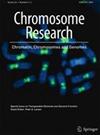基于cre - loxp的人类HAP1细胞组合染色体重排方法
IF 2.8
4区 生物学
Q3 BIOCHEMISTRY & MOLECULAR BIOLOGY
引用次数: 0
摘要
由染色体重排引起的人类核型改变通常与相当大的表型效应相关。研究这些效应背后的分子机制需要一个有效的、可扩展的实验模型。在这里,我们提出了一种基于cre - loxp的方法来产生染色体重排的组合多样性。我们证明,使用开发的系统,在人类单倍体HAP1细胞中,染色体内和染色体间的重排都可以诱导,尽管后者的效果明显较差。获得的基因修饰HAP1细胞系可用于解剖与染色体内结构变异相关的基因组效应。本文章由计算机程序翻译,如有差异,请以英文原文为准。

A Cre-LoxP-based approach for combinatorial chromosome rearrangements in human HAP1 cells.
Alterations of human karyotype caused by chromosomal rearrangements are often associated with considerable phenotypic effects. Studying molecular mechanisms underlying these effects requires an efficient and scalable experimental model. Here, we propose a Cre-LoxP-based approach for the generation of combinatorial diversity of chromosomal rearrangements. We demonstrate that using the developed system, both intra- and inter-chromosomal rearrangements can be induced in the human haploid HAP1 cells, although the latter is significantly less effective. The obtained genetically modified HAP1 cell line can be used to dissect genomic effects associated with intra-chromosomal structural variations.
求助全文
通过发布文献求助,成功后即可免费获取论文全文。
去求助
来源期刊

Chromosome Research
生物-生化与分子生物学
CiteScore
4.70
自引率
3.80%
发文量
31
审稿时长
1 months
期刊介绍:
Chromosome Research publishes manuscripts from work based on all organisms and encourages submissions in the following areas including, but not limited, to:
· Chromosomes and their linkage to diseases;
· Chromosome organization within the nucleus;
· Chromatin biology (transcription, non-coding RNA, etc);
· Chromosome structure, function and mechanics;
· Chromosome and DNA repair;
· Epigenetic chromosomal functions (centromeres, telomeres, replication, imprinting,
dosage compensation, sex determination, chromosome remodeling);
· Architectural/epigenomic organization of the genome;
· Functional annotation of the genome;
· Functional and comparative genomics in plants and animals;
· Karyology studies that help resolve difficult taxonomic problems or that provide
clues to fundamental mechanisms of genome and karyotype evolution in plants and animals;
· Mitosis and Meiosis;
· Cancer cytogenomics.
 求助内容:
求助内容: 应助结果提醒方式:
应助结果提醒方式:


